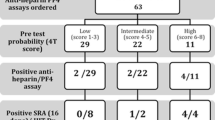Abstract
Heparin Induced Thrombocytopenia (HIT) is a serious complication from administration of heparin products. The 4T score is a validated pre-test probability tool to screen for HIT in hospitalized patients. As the negative predictive value (NPV) is very high further testing for HIT in patients with a low score can be avoided. Our objective was to determine trends at our hospital with respect to utilization of HIT antibody (HITAb) testing and evaluate economic burden from unnecessary HIT testing. A retrospective cohort review was performed on patients age 18 and above admitted to a tertiary care center from February 2013 to December 2014 who underwent HITAb testing. Surgical ICU patients were excluded. Patients were stratified into low, intermediate, and high risk for HIT based on the 4T model. Statistical analysis was performed using Chi square and regression models. Of 150 patients that underwent HITAb testing, 134 met inclusion criteria. 73 were male (54.47 %) and mean age was 55.50 ± 17.27 years. 81 patients had a low 4T score 0–3. Analysis of testing trends showed 60.44 % of patients were tested for HITAb despite being low risk using the 4T model. Only three patients with low 4T score were positive on confirmatory SRA testing (NPV 96.29 % CI 95 = 89.56–99.23 %). Expenditure due to inappropriate testing and treatment was estimated at $103,348.13. The majority of HITAb testing was found unnecessary based on the investigator calculated 4T score. We propose implementation of an electronic medical record (EMR) based calculator in order to reduce unneeded tests and reduce use of costlier alternative anticoagulants.



Similar content being viewed by others
Abbreviations
- CCU:
-
Coronary Care Unit
- EMR:
-
Electronic medical record
- ELISA:
-
Enzyme-linked immunosorbent assay
- HIT:
-
Heparin Induced Thrombocytopenia
- HEP:
-
HIT expert probability
- ICU:
-
Intensive care unit
- PF-4:
-
Platelet factor 4
- O.D.:
-
Optical density
- SRA:
-
Serotonin release assay
- SICU:
-
Surgical Intensive Care Unit
References
Kelton JG, Warkentin TE (2008) Heparin-induced thrombocytopenia: a historical perspective. Blood 112(7):2607–2616
Rauova L, Zhai L, Kowalska MA, Arepally GM, Cines DB, Poncz M (2006) Role of platelet surface PF4 antigenic complexes in heparin-induced thrombocytopenia pathogenesis: diagnostic and therapeutic implications. Blood 107(6):2346–2353
Rauova L, Poncz M, McKenzie SE, Reilly MP, Arepally G, Weisel JW et al (2005) Ultralarge complexes of PF4 and heparin are central to the pathogenesis of heparin-induced thrombocytopenia. Blood 105(1):131–138
Sachais BS, Litvinov RI, Yarovoi SV, Rauova L, Hinds JL, Rux AH et al (2012) Dynamic antibody-binding properties in the pathogenesis of HIT. Blood 120(5):1137–1142
Greinacher A, Potzsch B, Amiral J, Dummel V, Eichner A, Mueller-Eckhardt C (1994) Heparin-associated thrombocytopenia: isolation of the antibody and characterization of a multimolecular PF4-heparin complex as the major antigen. Thromb Haemost 71(2):247–251
Warkentin TE (1999) Heparin-induced thrombocytopenia: a clinicopathologic syndrome. Thromb Haemost 82(2):439–447
Warkentin TE, Levine MN, Hirsh J, Horsewood P, Roberts RS, Gent M et al (1995) Heparin-induced thrombocytopenia in patients treated with low-molecular-weight heparin or unfractionated heparin. N Engl J Med 332(20):1330–1335
Girolami B, Prandoni P, Stefani PM, Tanduo C, Sabbion P, Eichler P et al (2003) The incidence of heparin-induced thrombocytopenia in hospitalized medical patients treated with subcutaneous unfractionated heparin: a prospective cohort study. Blood 101(8):2955–2959
Martel N, Lee J, Wells PS (2005) Risk for heparin-induced thrombocytopenia with unfractionated and low-molecular-weight heparin thromboprophylaxis: a meta-analysis. Blood 106(8):2710–2715
Linkins LA, Dans AL, Moores LK, Bona R, Davidson BL, Schulman S et al (2012) Treatment and prevention of heparin-induced thrombocytopenia: antithrombotic therapy and prevention of thrombosis, 9th ed: American College of Chest Physicians Evidence-Based Clinical Practice Guidelines. Chest 141(2 Suppl):e495S–e530S
Warkentin TE (2011) How I diagnose and manage HIT. ASH Educ Program B 1:143–149
Warkentin TE, Kelton JG (1996) A 14-year study of heparin-induced thrombocytopenia. Am J Med 101(5):502–507
Warkentin TE, Greinacher A, Koster A, Lincoff AM (2008) Treatment and prevention of heparin-induced thrombocytopenia: American College of Chest Physicians Evidence-Based Clinical Practice Guidelines (8th Edition). Chest 133(6 Suppl):340S–380S
Warkentin TE (2012) HIT: treatment easier, prevention harder. Blood 119(5):1099–1100
Patrick AR, Winkelmayer WC, Avorn J, Fischer MA (2007) Strategies for the management of suspected heparin-induced thrombocytopenia: a cost-effectiveness analysis. Pharmacoeconomics 25(11):949–961
Lo GK, Juhl D, Warkentin TE, Sigouin CS, Eichler P, Greinacher A (2006) Evaluation of pretest clinical score (4 T’s) for the diagnosis of heparin-induced thrombocytopenia in two clinical settings. J Thromb Haemost 4(4):759–765
Cuker A, Gimotty PA, Crowther MA, Warkentin TE (2012) Predictive value of the 4Ts scoring system for heparin-induced thrombocytopenia: a systematic review and meta-analysis. Blood 120(20):4160–4167
Chaturvedi S, Kohli R, McCrae K (2015) Over-testing for heparin induced thrombocytopenia in hospitalized patients. J Thromb Thrombolysis 40(1):12–16
Cuker A (2011) Heparin-induced thrombocytopenia (HIT) in 2011: an epidemic of overdiagnosis. Thromb Haemost 106(6):993–994
Cuker A, Cines DB (2012) How I treat heparin-induced thrombocytopenia. Blood 119(10):2209–2218
Acknowledgments
The study was funded by a grant provided by the University of Nevada School of Medicine, Office of Medical Research. Funding source had no role in study design, conduct of study, collection, management, analysis, or interpretation of data; or in review, preparation, and approval of the manuscript.
Author information
Authors and Affiliations
Corresponding author
Ethics declarations
Conflict of Interest
None
Rights and permissions
About this article
Cite this article
Hasan, M., Malalur, P., Agastya, M. et al. A high-value cost conscious approach to minimize heparin induced thrombocytopenia antibody (HITAb) testing using the 4T score. J Thromb Thrombolysis 42, 441–446 (2016). https://doi.org/10.1007/s11239-016-1396-6
Published:
Issue Date:
DOI: https://doi.org/10.1007/s11239-016-1396-6




